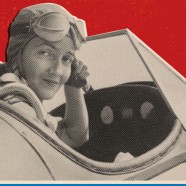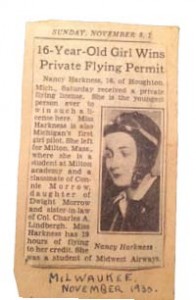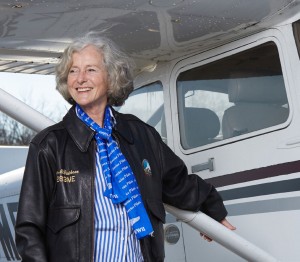
by Mary McCutcheon ’65
Imagine enjoying a beautiful autumn afternoon on the Quad. Suddenly your tranquility is shattered by an airplane descending perilously low over the chapel and rattling off the top of one of the crenellations. This happened one Sunday in the fall of 1930. The usual suspects were the daredevil Fuller brothers, both of whom had pilot’s licenses. But, to the astonishment of the administration, the culprit proved to be a girl! It was the demure and pretty senior, Nancy Harkness.
I remember my Class I year at Milton. It was 1965 and I, too, was captivated by flying. On a similar afternoon, I took my first flying lesson out of Hanscom Field in Bedford. I had no idea at that time that Milton had an illustrious history in the annals of aviation. All I knew was that my favorite teacher, the handle-bar-mustachioed Mr. Pierce, had flown in World War I for France.
After I got my license, I met some of the Women Airforce Service Pilots (WASP) and even became a kind of groupie. The WASP were women who flew in various noncombat capacities during World War II. One of them, Dot Swain Lewis, had been a flight instructor. I listened to her many stories, envying the kind of sisterhood that emerged from the WASP. After the war, she and other WASP found they had few prospects either in commercial or military aviation and, with good entrepreneurial spirit, joined an all girls air show and flying circus. Dot played the part of a frumpy schoolmarm who stumbles myopically into a Piper Cub and accidentally takes off. She then does barrel rolls, loops, spins and hammerhead stalls to the delight of the audience.
Through these WASP connections, I learned about Nancy Harkness and how she founded the Women’s Auxiliary Ferrying Squadron, one of the two components of the WASP. The added joy was finding out she had gone to Milton, too.
She came from Houghton, Michigan, and enrolled at Milton in 1928. Academically she did respectable but not brilliant work. Nor was she especially athletic, showing more aptitude in tap dancing than in team sports.
 At the end of the summer before her senior year, something turned an indifferent teenager into a major character in the history of aviation. In late August 1930, Nancy was riding her horse on a big field in Michigan’s Upper Peninsula, when a barnstormer landed and offered to take her for a ride. The encounter evolved into formal lessons and, after four hours and 30 minutes of flying time and only six days since her first flight, Nancy soloed. Between then and her return to school on September 10, she accrued 13 hours and 25 minutes with an instructor and another 9 hours and 40 minutes of solo time. The total was enough to earn her pilot’s license. I have read that she was the youngest woman to be licensed as a pilot at that time and among only 200 other women pilots.
At the end of the summer before her senior year, something turned an indifferent teenager into a major character in the history of aviation. In late August 1930, Nancy was riding her horse on a big field in Michigan’s Upper Peninsula, when a barnstormer landed and offered to take her for a ride. The encounter evolved into formal lessons and, after four hours and 30 minutes of flying time and only six days since her first flight, Nancy soloed. Between then and her return to school on September 10, she accrued 13 hours and 25 minutes with an instructor and another 9 hours and 40 minutes of solo time. The total was enough to earn her pilot’s license. I have read that she was the youngest woman to be licensed as a pilot at that time and among only 200 other women pilots.
She was consumed by a passion for flying from then on. Her daughter, Allie (Milton Class of 1969), showed me her notebook covers. My cover doodles at Milton showed hairstyles or caricatures of my teachers. Nancy’s showed her love of airplanes.
She never finished Vassar, but in her three years there she started a flying club and became a local celebrity as a gorgeous, young, socialite, girl pilot. Because of people like her (and Amelia Earhart and Louise Thaden), girls realized that the dream of flying was attainable. The ’30s saw a tenfold increase in women earning pilot’s licenses—a resource that would soon prove vital.
After Vassar, Nancy embarked on various jobs in aviation and married fellow pilot, Robert Love, in 1936. Both of them continued to work and fly as the ominous threats of war brewed first in Europe and East Asia and inevitably here in the U.S. Then came Pearl Harbor and the heartbreaking sequence of defeats in the first part of 1942.
Using women pilots would solve a growing problem: ferrying aircraft from the factories to the bases. Women were readily available to do this work, and two of them were offering their services to mobilize the forces: One was Jackie Cochran and the other was Nancy Harkness Love. Both women were told by various levels of command “maybe,” “no,” “not yet,” “I’ll get back to you,” “someday,” and then eventually, “YES.”
The personalities of these two women were starkly opposite. They were both young, glamorous and highly skilled pilots, but Jacqueline Cochran came from a hardscrabble north Florida background and did a personal makeover to conform to the person she wanted to be. She was actually in the makeover business, the owner of a cosmetics company. She married a millionaire and was off and running. Ever a self-promoter, she won publicity for all of her many aviation accomplishments and had contacts in very high places, including the White House. Meanwhile, Nancy Love, from a highly educated, old New England family, was modestly perfecting her flying skills. When Nancy Love was given the go-ahead for her proposed ferrying idea, Jackie Cochran went ballistic. Aware of the clout she had with the Roosevelts, General Hap Arnold appeased her by giving her the go-ahead as well. He had the idea that they would complement one another. This led to two different women’s programs: one for large-scale, production-line training called the Women’s Flight Training Command run by Jackie Cochran, and the other for the more experienced pilots who would ferry airplanes from factories to military bases. This was Nancy Love’s WAFS or Women’s Auxiliary Ferrying Squadron. The 28 women who were WAFS are known as “The Originals.”
After nine months of strained coexistence, the two programs were subsumed under the centralized WASP in June 1943, with Jackie Cochran as director. Nancy Love remained the head of the ferrying program.
When a disempowered person breaks into a realm previously out of reach, he or she feels a special burden to behave contrary to the negative stereotypes of their group. For Nancy Love, it was of paramount importance NOT to bicker and whine. For her “girls” (as they were called), it was of paramount importance that they NOT be involved in compromising moral situations, NOT let minor biological realities interfere, and NOT lose stamina.
To keep up the professionalism, the girls covered for pregnant fellow pilots until their pregnancies precluded the use of the control stick. Nancy Love argued over and over again that menstruation need not be a disability and that women do not always become shrieking harridans during their periods. She also emphasized to disbelieving men that collegial relations with male ferry pilots can be completely platonic.
After the war, none of these women got the credit they deserved. They had no military benefits (and only belatedly were militarized in 1977). They resumed their normal lives, marrying and having children, and, in only a few cases (like Dot Lewis and her All Woman Air Show), kept flying at all.
Nancy and Bob Love started their family. Bob started a small regional airline that grew into Allegheny Airlines. They moved to Martha’s Vineyard and started a shipyard, too. Their lives were quiet. Until her death from cancer in 1976, Nancy’s contribution to the world of aviation and to the war effort was remembered with an occasional award here and medal there, a chapter in a book now and a dissertation then. For the most part, the work of these women pilots was largely forgotten.

Mary McCutcheon is a pilot whose passion for flying began at Milton. She and her brother “snuck away” from campus and made their way via MTA to Hanscom Field for flying lessons. She got her license in 1996 and a plane of her own in 2000. Mary is a cultural anthropologist who has specialized in the Palau Islands in Micronesia. In addition to research and writing, she has worked at the Smithsonian and as a faculty member at George Mason University.
More recently, thanks to historians, museums, and the children and grandchildren of these women, films, exhibits, large archival collections, and awards are attracting attention to Nancy Love and her fellow women pilots of World War II. Nancy Love was inducted into the International Forest of Friendship in 1979 and enshrined in the National Aviation Hall of Fame in 2005. All of the WASP won the Congressional Gold Medal in 2010, and Nancy’s daughters were there to accept it.
Today, over 25,000 women are active pilots in the United States; they have broken all the barriers and even may be setting new standards. I met the third female member of the Air Force Thunderbird team, Lt. Col. Caroline Jensen, and she told me that, before a Thunderbird show, a fellow pilot admonished her not to “fly like a girl.” “Oh, I wouldn’t do that,” she replied. “It might make the boys look bad!”
Thanks to Sarah Byrn Rickman, whose series of three books about Nancy Love and the WAFS were the basis for most of my biographical details (The Originals [2001], Nancy Love and the WASP Ferry Pilots of World War II [2008], and WASP of the Ferry Command [2016]). Thanks also to Allie Love, who shared her mother’s collection with me in December 2016. Thanks also to Julia Lauria Blum, who has, as archivist for the Cradle of Aviation, in Garden City, New York, kept memories of the WAFS and other aviation triumphs on Long Island alive. Thanks to Albert Lewis, the son of Dorothy Swain Lewis, for introducing me to his mother. Credit also goes to the archivists at Texas Woman’s University, whose WASP archive has maintained WASP material, including the transcript of Teresa James’s oral history. And thanks to Lt. Col. Caroline Jensen for sharing her story.



